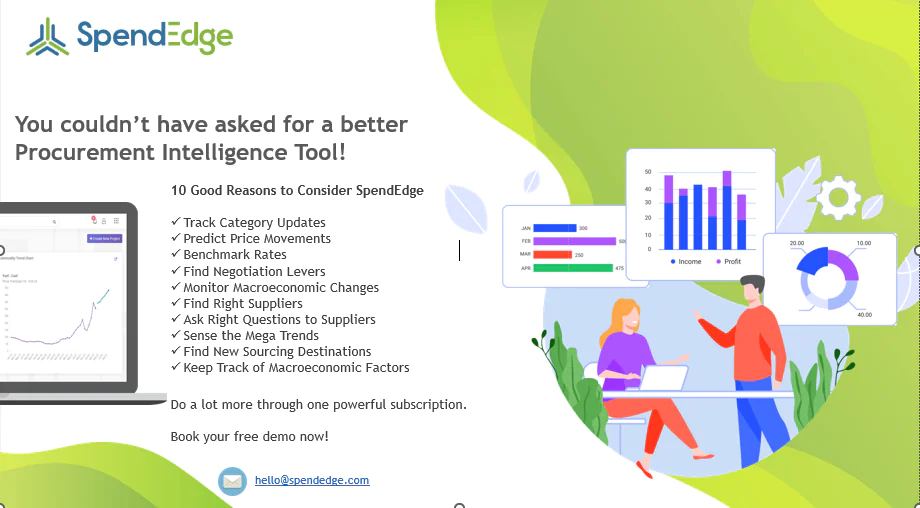A thorough cost-benefit analysis is essential in the Make vs Buy decision, particularly when evaluating the most economical procurement decision. Factors such as storage costs, labor costs, and shipping expenses can significantly influence overall financial efficiency. Equally important is supplier reliability and the strength of supplier contracts. Reliable suppliers and well-structured agreements ensure consistent quality and timely delivery, helping to mitigate risks typically associated with external vendors.
Expertise and volume requirements also play a key role in shaping the procurement decision. When internal capabilities are limited or when production volumes are small, outsourcing may be the more practical and cost-effective solution. Additionally, understanding market demand and maintaining flexibility are crucial. By analyzing demand fluctuations and consulting price trends, companies can make strategic procurement decisions that offer agility and adaptability in response to changing market conditions.
Make vs Buy Decision in Manufacturing
In the ecosystem of manufacturing, companies are often faced with the critical decision of whether to produce components, parts, or products in-house (make) or to outsource them from external suppliers (buy). This decision, known as the “Make vs Buy” decision, carries significant implications for cost, quality, flexibility, and risk management. It requires careful consideration of various factors to optimize both financial resources and operational efficiency.
Key factors influencing this decision include:
| Key Factor | Explanation | Impact on Decision |
|---|---|---|
| Cost Efficiency | Includes storage, shipping, labor, and transaction costs involved in making or buying. | Make: High initial investment in machinery and labor; Buy: Potentially lower upfront costs but ongoing supplier costs and transaction management. |
| Labor and Expertise | The availability of skilled labor and expertise in manufacturing processes. | Make: Requires investment in skilled labor and continuous training. Buy: Outsourcing can provide access to specialized skills and reduce internal labor costs. |
| Quality Control | The ability to meet quality standards and ensure product consistency. | Make: Direct control over quality assurance and customization. Buy: Risk of quality variation depending on the supplier’s capabilities. |
| Supplier Reliability | The dependability of external suppliers to deliver on time and as per specifications. | Make: No dependency on external factors; Buy: Relies heavily on supplier relationships and performance. |
| Volume Flexibility | The ability to scale production up or down based on demand fluctuations. | Make: Flexibility in scaling may be limited by capacity. Buy: Easier to adjust production volumes with external suppliers based on demand. |
| Strategic Alignment | Whether the decision supports long-term business goals and operational strategy. | Make: Offers control over production, innovation, and long-term sustainability. Buy: Allows the company to focus on core competencies, enabling flexibility for strategic shifts. |
What Is a Make-or-Buy Decision?
Making the decision to either manufacture a product internally or buy it from an outside provider is known as a “make-or-buy” decision. A make-or-buy choice, also known as an outsourcing decision, weighs the advantages and disadvantages of using an outside provider for the relevant resources vs producing the essential good or service internally. This type of procurement decision is fundamental to strategic sourcing and operations planning.
Benefits of a Make-or-Buy Decision
Key benefits
- Reduce Expenses and Increase Capital Investments
- Gain a Competitive Advantage
- Optimized Resource Allocation
- Improved Risk Management
- Scalability and Flexibility
- Access to Advanced Technologies
1. Reducing Expenses and Increasing Capital Investments
A well-executed make-or-buy decision can significantly reduce operational costs and enable better capital investments. Whether manufacturing in-house or outsourcing, companies can strategically lower production costs. In-house production may require a larger initial investment in machinery, technology, and labor, but can lower long-term expenses. Alternatively, outsourcing allows firms to bypass these upfront costs, reducing overheads while focusing on improving their core functions. By making the right procurement decision, companies can reinvest the saved resources into growth, R&D, or expanding their competitive advantages.
2. Gain a Competitive Advantage
A make-or-buy decision can provide businesses with a competitive advantage by enhancing operational efficiency and innovation. By outsourcing non-core functions, companies can focus on their strengths, be it customer service, product development, or marketing, allowing them to stay ahead of competitors. Additionally, the flexibility of this approach enables businesses to quickly adjust to market changes and customer demands, fostering agility. Whether keeping production in-house for control or choosing suppliers for flexibility, this strategic procurement decision enables companies to offer superior value, differentiate from competitors, and improve market positioning.
3. Optimized Resource Allocation
The make-or-buy decision allows businesses to strategically allocate resources, ensuring that internal capabilities are focused on high-priority tasks while outsourcing less critical functions. By outsourcing production or services that do not align with core competencies, companies can improve operational efficiency and avoid resource wastage. This approach optimizes manpower, capital, and technology investments, empowering organizations to increase productivity and maintain a competitive edge. Allocating resources in this way supports an informed procurement decision and helps companies remain focused on innovation, customer experience, and growth.
4. Improved Risk Management
A carefully considered make-or-buy strategy enhances a company’s risk management framework. By outsourcing certain operations, businesses can reduce exposure to supply chain disruptions, market fluctuations, and production inefficiencies. Outsourcing to reliable suppliers allows businesses to spread risk, ensuring continuity even during unforeseen challenges, such as raw material shortages or labor strikes. Moreover, when internal production is retained for critical operations, it offers greater control over quality and performance. This balanced procurement decision helps businesses navigate unpredictable markets with greater resilience, ensuring smooth operations and sustained growth.
5. Scalability and Flexibility
Scalability and flexibility are significant advantages of the make-or-buy decision. By outsourcing production, companies can rapidly scale operations without large capital expenditures or the need for additional infrastructure. This scalability allows businesses to respond quickly to fluctuations in market demand, ensuring they can meet customer needs efficiently. On the other hand, in-house production offers more control over the pace and quality of scaling. Whether ramping up production to meet demand spikes or adjusting operations in response to market shifts, a well-timed procurement decision ensures operational agility while minimizing risks and maximizing growth opportunities.
6. Access to Advanced Technologies and Innovations
Outsourcing provides businesses with access to cutting-edge technologies and innovations that might otherwise be unavailable or too costly to develop in-house. Suppliers often invest heavily in research and development, enabling businesses to benefit from the latest advancements in production methods, automation, and quality control. By leveraging these innovations, companies can enhance their product offerings, improve efficiency, and accelerate time-to-market. This access to advanced technologies strengthens the overall procurement decision, allowing businesses to stay ahead of trends while maintaining high standards.
Understanding the Make Vs Buy Decision
The Make vs Buy decision is a strategic choice that involves weighing the advantages and disadvantages of internal production versus external procurement. Both options come with their own set of pros and cons, and the decision-making process should be guided by a comprehensive analysis of several factors:
Cost considerations
Capacity and Capability
Risk management
Flexibility and Agility
- Cost Considerations: One of the primary drivers of the Make vs Buy decision is cost. This involves not only the direct expenses associated with production or procurement but also indirect costs such as overhead, labor, maintenance, and inventory carrying costs. Companies must conduct a thorough cost analysis to determine which option offers the most economical procurement decision in the long run.
- Capacity and Capability: Internal production offers greater control over quality, customization, and production schedules. However, it requires substantial investments in machinery, equipment, and skilled labor. Outsourcing, on the other hand, allows companies to leverage the capabilities of specialized suppliers without the need for significant capital expenditure. Assessing the company’s internal capacity and capabilities is crucial in making an informed decision.
- Risk Management: Risk management plays a pivotal role in the Make vs Buy decision. Internal production may entail risks such as production bottlenecks, equipment failures, and supply chain disruptions. Outsourcing can mitigate some of these risks by diversifying the supplier base and offloading certain responsibilities to external partners. However, it also introduces risks related to quality control, delivery delays, and intellectual property protection.
- Flexibility and Agility: In today’s dynamic business environment, flexibility and agility are paramount. Internal production offers greater flexibility in responding to changing market demands and product customization requirements. However, outsourcing can provide access to specialized expertise and resources, enabling companies to adapt quickly to market fluctuations and scale production up or down as needed.
Leverage data-driven insights and expert analysis to make strategic decisions that enhance efficiency and profitability. Contact us to explore customized solutions tailored to your business needs…
Deciding Between In-House Production and External Suppliers: Make or buy
Quantitative Analysis
To make an informed procurement decision, it’s essential to assess cost-effectiveness by comparing equipment costs, storage expenses, and labor costs for both in-house production and outsourcing. This comparison helps determine the most cost-efficient approach. Additionally, evaluating the overall operational costs including inventory management and logistics provides a comprehensive understanding of which option offers better financial outcomes in the long run.
Qualitative Factors
When making a procurement decision, several qualitative factors come into play. If a business lacks the necessary in-house expertise or technology for production, outsourcing becomes a more viable and efficient option. In cases of small volume requirements, relying on external suppliers is often more practical than investing heavily in infrastructure and resources for in-house production. Additionally, if the product in question is non-critical to the company’s core strategy, outsourcing enables the organization to concentrate on higher-priority areas, improving overall strategic focus and resource allocation.
Supplier Reliability
Quality control is a vital aspect of any procurement decision. It’s important to assess a supplier’s ability to consistently maintain high-quality standards and reliably meet operational demands. Equally crucial is evaluating the stability of the supplier’s supply chain. A dependable external partner should be able to provide a predictable and steady flow of products, minimizing the risk of disruptions and ensuring continuity in production and service delivery.
Supplier Contracts
Establishing long-term agreements is a key component of a successful procurement decision. Robust supplier contracts help guarantee consistent performance, stable pricing, and reliable supply timelines, all of which are essential for maintaining smooth operations. These agreements also play a significant role in risk mitigation by reducing exposure to unreliable suppliers and unforeseen operational challenges. By securing well-structured contracts, businesses can enhance supply chain stability and protect against potential disruptions.
Market Demand and Price Considerations
When making a procurement decision, it’s important to account for demand fluctuations. In cases where demand is volatile, outsourcing offers the flexibility to scale production up or down quickly without incurring the fixed costs associated with in-house manufacturing. Additionally, conducting a thorough price analysis by reviewing price charts and cost trends helps identify which option making or buying offers a more competitive pricing strategy over time. This ensures the company remains cost-effective and responsive to market dynamics.
Proven Track Record of Suppliers
Supplier reputation plays a crucial role in making an effective procurement decision. Partnering with a supplier known for consistently delivering high-quality products and services ensures greater reliability and operational efficiency. Furthermore, building long-term partnerships with trusted suppliers enhances business continuity and helps streamline processes. Such relationships foster mutual understanding, improved coordination, and more dependable outcomes over time.
Cost Minimization Strategies
To minimize costs and maximize efficiency in the Make vs Buy decision, manufacturers can implement several strategies:
- Total Cost Analysis: Conduct a comprehensive analysis of the total cost of ownership (TCO) for both in-house production and outsourcing. This should include not only direct costs but also indirect costs such as transportation, inventory carrying, quality control, and overhead expenses.
- Economies of Scale: Evaluate the economies of scale associated with both options. In-house production may offer cost advantages at higher production volumes, while outsourcing can leverage the economies of scale achieved by specialized suppliers.
- Supplier Negotiation: Negotiate favorable terms with external suppliers to ensure competitive pricing, quality standards, and delivery schedules. Long-term partnerships and strategic alliances with reliable suppliers can yield cost savings and operational efficiencies.
- Lean Manufacturing Practices: Implement lean manufacturing principles to streamline production processes, eliminate waste, and optimize resource utilization. Continuous improvement initiatives such as Six Sigma and Kaizen can drive down costs and enhance productivity.
- Risk Mitigation Strategies: Develop contingency plans and risk mitigation strategies to address potential disruptions in the supply chain, production delays, or quality issues. Diversifying the supplier base, maintaining safety stock, and implementing robust quality control measures can help mitigate risks associated with outsourcing.
Discover how our expertise can help you streamline operations, reduce costs, and improve agility in your Make vs Buy decisions…
Conclusion
The Make vs Buy decision is a complex process that requires careful evaluation of cost, capacity, capability, risk, and flexibility considerations. By conducting a thorough analysis and implementing cost minimization and risk management strategies, manufacturers can make informed procurement decisions that optimize both financial performance and operational efficiency. Whether opting for internal production or outsourcing, the ultimate goal is to achieve a competitive advantage in the marketplace while delivering value to customers.






